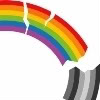 I am ecstatic to see the most recent “Special Section” of the Star Ledger Magazine, dated May 31, 2011, dedicated, solely, to the purposes of making visible queer New Jerseyeans (and, apparently the “community’s” buying power as evidenced by the many consumer ads placed throughout), but I am troubled by the issue’s utter failure to irradiate all of the diverse “textures” and “colors” that its picturesque, rainbow-colored title page ostensibly seeks to reveal.
I am ecstatic to see the most recent “Special Section” of the Star Ledger Magazine, dated May 31, 2011, dedicated, solely, to the purposes of making visible queer New Jerseyeans (and, apparently the “community’s” buying power as evidenced by the many consumer ads placed throughout), but I am troubled by the issue’s utter failure to irradiate all of the diverse “textures” and “colors” that its picturesque, rainbow-colored title page ostensibly seeks to reveal.
Inside Jersey: Living Gay in the Garden State offers readers a disturbingly myopic frame of a “gay” Jersey that is, literally, monochromatic and insular in its lack of representation of non-white, non-suburban and non-middle class queer New Jerseyeans. What could have been a nuanced and commemorative segment ends up being nothing more than a seemingly under-researched piece that is certain to offend anyone who hoped, like me, to browse the segment and see a semblance of racial, ethnic, economic, neighborhood, and cultural diversity on any of the pages. But, maybe I am misreading the articles and images in failing to see the diversity that the editors intended to present beyond that of sexual identity.
This Special Section highlights a few exceptional locales where queer persons and families exist; however, queer New Jerseyeans also reside contentedly in urban spaces like Camden, Paterson, Trenton, Jersey City, Elizabeth, and Newark, as well. While we tend to turn to suburban, middle-class municipalities and townships like Collingswood (I grew up in neighboring Camden) and Maplewood (I went to undergrad in neighboring South Orange) as progressive, forward-thinking communities where queers can live comfortably, it is vitally important to consider the lives of queers who live outside of those spaces.
For example, I’ve lived (until recently) and am active in the city of Newark and have experienced the strongest sense of community and welcome as a queer man of color than any other spaces, including suburban locales like Laurel Springs and Princeton to name a few. To be sure, Newark (while it has its share of issues) was the first city in New Jersey to establish an official government instrumentality that advises the Mayor’s office on LGBTQ concerns. In fact, it was a coalition of mostly Newark-based advocates and not Maplewood or Montclair residents—along with a few representatives from Garden State Equality including Steve Goldstein, who worked with the county of Essex to establish a similar county-wide body this past year. Newark has been home to one of the state’s—and region’s—most celebrated pride week’s, namely, Newark-Essex Pride Week, for several years bringing Newarkers and non-Newarkers into communal celebration. Newark is home to the Hetrick-Martin Institute’s HMI-to-Go program, an initiative of the oldest and largest LGBTQ youth-serving organization in the world, which provides academic and mental health supports to Newark youth. Newark, under the auspices of the office of Mayor Cory A. Booker, was the host location for a brunch sponsored by the New York Chapter of the National Lesbian & Gay Journalists Association in 2009. And, there’s so much more to say about Newark, which is only one of the few urban spaces where queers exist, which has been left out of the writers’ narratives describing queer Jersey.
Queers in New Jersey are diverse (i.e. non-white, Latino/Hispanic, working and jobless poor, non-married/non-partnered families, rural and urban, and/or non-LGBTQ identified) beyond the ways they are typified within this Special Section. The fact that the editors failed to illumine this fact leaves no other choice but for one to wonder about the absence. If it’s the case that the section seeks to drive a consumerist market towards the purchase of everything from cabaret show tickets to condominiums or that writers traced the usual trail of news stories (or lack thereof) located in media outlets focused on queer Jersey, then it is clear why the issue proves problematic. Whatever the case, I failed to see my queer, black, urban reflection in the rainbow-esque offering, and I am afraid that others might fail to see reflections of themselves, as well.
You must be logged in to post a comment.